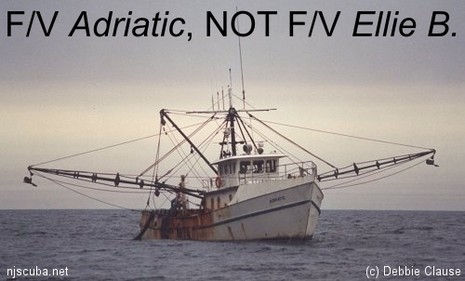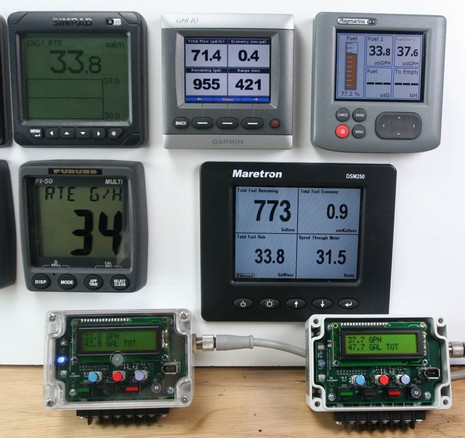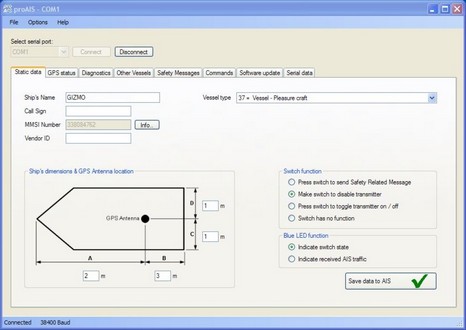Nasa/Si-Tex AIS receiver, first impressions

Well, I’m beginning to understand why the Nasa AIS receiver is so much less expensive than most others on the market (besides the single frequency business). For one thing, the wire connections to the “not waterproof” box are funky compared to most marine electronics. Above you can see how an install might look if you use its ability to blend a GPS into its data stream. Note how the red power wire uses a pin connector with no lock (if your boat is rattlely, you might want to duct tape it). The illustration, by the way, is from an installation pdf that Digiboat put together, which is way better than what came with the unit.
Then there’s the fact that once you’ve wired the receiver to antenna, PC, and power, you have no way to know if it works. No LEDs, no NMEA strings unless it’s actually receiving targets. Without a real manual, I had no way of knowing what was going on so I e-mailed customer support at Digiboat, who seem to know this hardware, and got a prompt response that confirmed my fears, “the NASA AIS Receiver gives NO INDICATION whether it’s working, or not – quite frustrating really. Unless, of course, you’re surrounded by transmitting targets.”
In fact, Simon Blundell from Digiboat has figured out a way to solder 4 useful status LEDs into the Nasa receiver, and has posted a thorough Web page about the project (check it out…this is DIY pioneering!). He also pointed out that I could check the install by doing the GPS bypass above. Nah…I will be in hotel right on the Mediterranean coast near Marseille, France, later this week, so hope to test with real targets. Blundell suggests that once I see how well the Nasa box works for the money, the negatives will fade. We’ll see.













Webpage instructions for adding the indicator LEDs to the NASA AIS Receiver are here:
http://www.digiboat.com.au/NASA_DIY_LED.htm
Re the nasa ais engine.
AIS data is transmitted alternately on the A and B channel. NASA,s receiver switches between each channel at a rate selected so as not to synchronise with the transmission rate. It is a psuedo two channel and, around the uk (where I use it) it works just as well, if not better than the two channel alternatives and at much lower cost.
Could you be thinking of the Comar single frequency receiver?:
https://panbo.com/yae/archives/001024.html
I believe the NASA/Si-Tex/Nobeltec receiver stays on one channel but can be switched to the other with software like Y-Tronics:
https://panbo.com/yae/archives/001138.html
I don’t understand how switching can be synchonized to transmission rate when each ship is sending out data at different times, some every six minutes, other strings every 2 seconds to 3 minutes.
Several GPSNavX and MacENC users are successfully using the Nasa Marine AIS engine. I agree one has to take a little initiative to make a marine ready installation. Once the receiver is properly connected (power, data, antenna) it works wonderfully. I do agree it would be very helpful if the receiver transmitted an empty NMEA sentence just to confirm the data connection was correct. An important point is that the NMEA data comes out at a rate of 38,400 compared with the typical 4,800 of most NMEA transmitters.
We tested the NASA AIS Receiver and it is quite simply AWFUL! It has the poorest sensitivity of any that we have tested. It barely received targets at 4 miles while others tested on the same antenna were receiving contacts at 60+ Nautical Miles.
We tested one ordered from Sitex and another ordered from Nobeltec just to see if we got a bad one.
I am very happy with my NASA AIS Engine (receiver). I wound up using a Brookhouse multiplexer to solve the data collision issues I had using the “blue wire”. I used the multiplexer to reduce the number of cables to my laptop, and as a bonus I added a couple of other NMEA strings. The Brookhouse unit accepts the 38,400 baud AIS output.
I am very pleased with the NASA unit. I recommend using soldered antenna connections.
Tried to download the info about adding LEDs to the NASA AIS black box – can’t get to the server. Is the address http://www.digiboat.com.au/NASA_DIY_LED.htm still good?
Cancel comment about the site/server – worked later. About the sensitivity comment – I have routinely seen AIS targets at 40nm+-. Antennas is 25′ above the water. I like it.
Nasa is now flogging a display program ‘PC Display for AIS Engine’ for 9.5GBP ($16.50). Current version is 1.03. You MUST buy the software to see how it works … the demo version doesn’t work at all. Quite frankly it is a kindergarten approach and not worth the money.
The ais engine sold in the USA under several brand names is made by Nasa Marine in England. It is very poular in Europe and outsells the competition. Discounters sell it at just over 100gbp.
I agree the “radar display ” looks fairly micky mouseish but I have used it in the English channel where I could see up to 40 ships moving around me as I crossed the shipping lanes. I can tell you it gave a better picture than my radar which cost 20 timer as much as the engine.
I got mine on E-bay from onlinemarinemart they included the radar software free so I think I got a good deal.
I cannot understand what major electric co were testing. I can get more than 4 miles with a staightened out paper clip pushed in the antenna socket and up to 60 miles withe my mast head antenna.
I am in the UK and subscribe to the ShipPlotter forum. A lot of radio amateurs here use the AIS Engine and they are also popular with leisure boaters. I have not heard any comments about it being particularly poor in sensitivity but it is the cheapest receiver that can be purchased in the UK. A news item came up recently about a company that had released a replacement chip for it that allowed class B transmissions to be received. I may invest in such a device as class B transmissions can be regularly received off the south coast, so I have read. Was wondering if there was anyone else doing a similar thing? Is this the only such product available or does anyone else know of others. Have noted URL above.